1996 CHEVROLET TAHOE warning
[x] Cancel search: warningPage 278 of 403
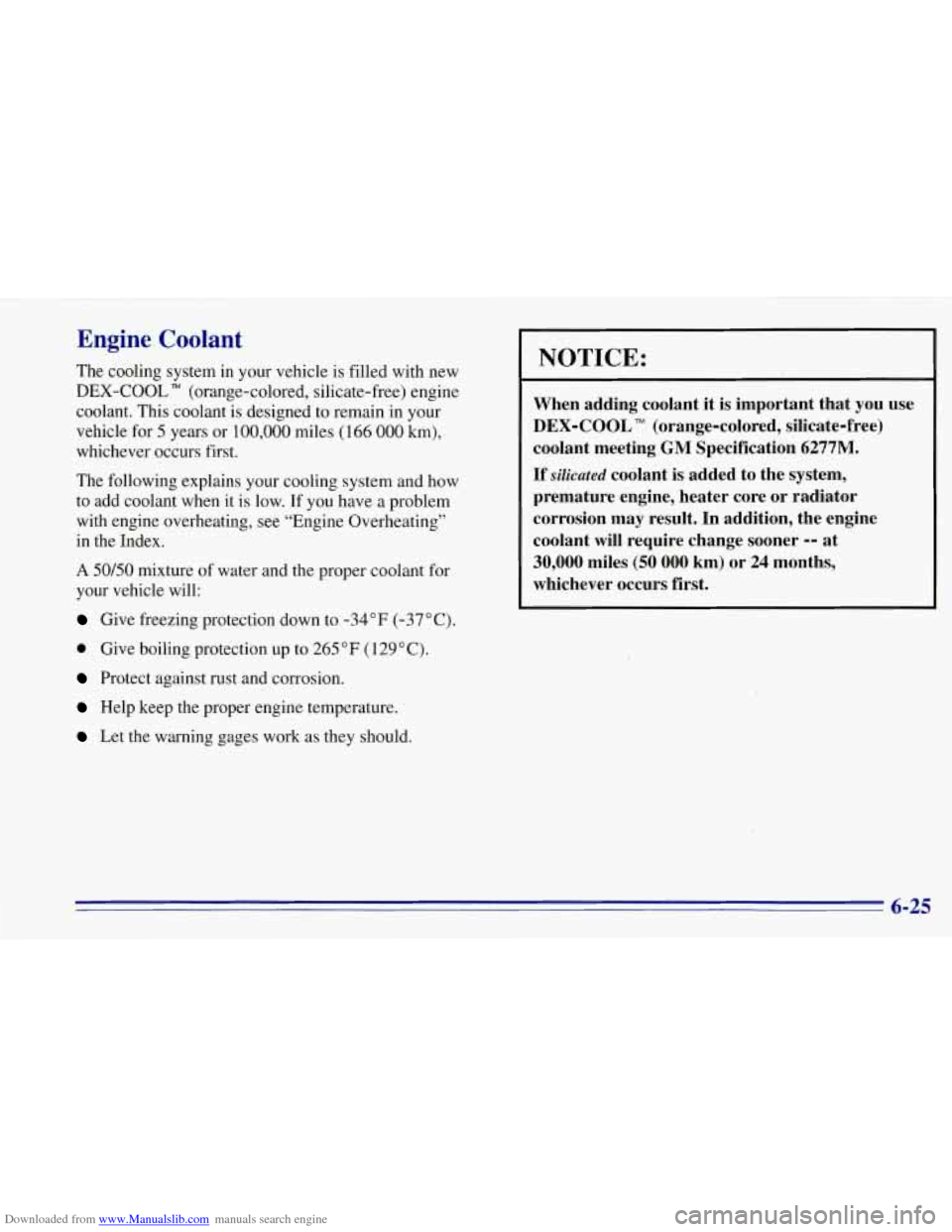
Downloaded from www.Manualslib.com manuals search engine Engine Coolant
The cooling system in your vehicle is filled with new
DEX-COOL TM (orange-colored, silicate-free) engine
coolant. This coolant is designed to remain in your
vehicle for
5 years or 100,000 miles (166 000 km),
whichever occurs first.
The following explains your cooling system and how
to add coolant when it is low. If you have a problem
with engine overheating, see “Engine Overheating”
in the Index.
A 50/50 mixture of water and the proper coolant for
your vehicle will:
Give freezing protection down to -34°F (-37°C).
0 Give boiling protection up to 265 “F (129 ” C).
Protect against rust and corrosion.
Help keep the proper engine temperature.
Let the warning gages work as they should.
NOTICE:
When adding coolant it is important that you use
DEX-COOL (orange-colored, silicate-free)
coolant meeting
GM Specification 6277111.
If silicated coolant is added to the system,
premature engine, heater core or radiator
corrosion may result. In addition, the engine
coolant will require change sooner
-- at
30,000 miles (50 000 km) or 24 months,
whichever occurs first.
6-25
Page 279 of 403
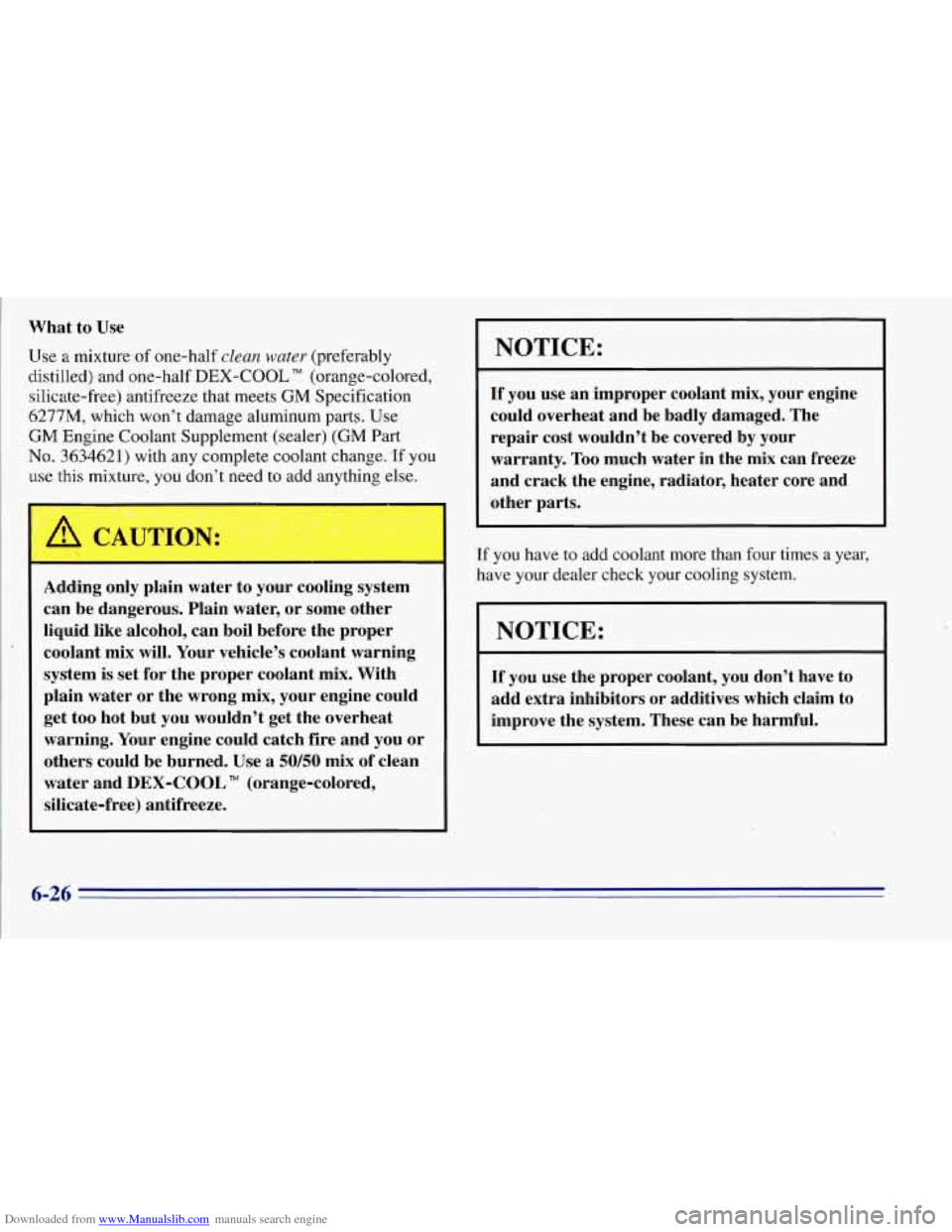
Downloaded from www.Manualslib.com manuals search engine What to Use
Use a mixture of one-half clean water (preferably
distilled) and one-half DEX-COOL
TM (orange-colored,
silicate-free) antifreeze that meets
GM Specification
6277M, which won’t damage aluminum parts. Use
GM Engine Coolant Supplement (sealer) (GM Part
No. 3634621) with any complete coolant change. If you
use this mixture, you don’t need
to add anything else.
Adding only plain water to your cooling system
can be dangerous. Plain water, or some other
liquid like alcohol, can boil before the proper
coolant mix will. Your vehicle’s coolant warning
system is set for ‘the proper coolant mix. With
plain water or the wrong mix, your engine could
get too hot but you wouldn’t get the overheat
warning. Your engine could catch fire and you or
others could be burned. Use
a 50/50 mix of clean
water and
DEX-COOL TM (orange-colored,
silicate-free) antifreeze.
NOTICE:
If you use an improper coolant mix, your engine
could overheat and be badly damaged. The
repair cost wouldn’t be covered by your
warranty.
Too much water in the mix can freeze
and crack the engine, radiator, heater core and
other parts.
[f you have to add coolant more than four times a year,
have your dealer check your cooling system.
NOTICE:
If you use the proper coolant, you don’t have to
add extra inhibitors
or additives which claim to
improve the system. These can be harmful.
6-26
Page 286 of 403

Downloaded from www.Manualslib.com manuals search engine NOTICE:
Using the wrong fluid can badly damage
brake system parts. For example, just a few
drops of mineral-based oil, such as engine
oil, in your brake system can damage brake
system parts
so badly that they’ll have to be
replaced. Don’t let someone put in the
wrong kind of fluid.
If you spill brake fluid on your vehicle’s
painted surfaces, the paint finish can be
damaged. Be careful not to spill brake fluid
on your vehicle.
If you do, wash it off
immediately. See “Appearance Care’’
in the Index.
Brake Wear
Your vehicle has front disc brakes and rear drum brakes.
Disc brake pads have built-in wear indicators that make a
high-pitched warning sound when the brake pads are worn
and new pads are needed. The sound may come and go or
be heard all the time your vehicle is moving (except when
you are pushing on the brake pedal firmly).
-
r, CAUTION: I
The brake wear warning sound means that sooner
or later your brakes won’t work well. That could
lead to an accident. When you hear the brake wear
warning sound, have your vehicle serviced.
I
NOTICE:
Continuing to drive with worn-out brake pads
could result in costly brake repair.
.
6-33
Page 301 of 403
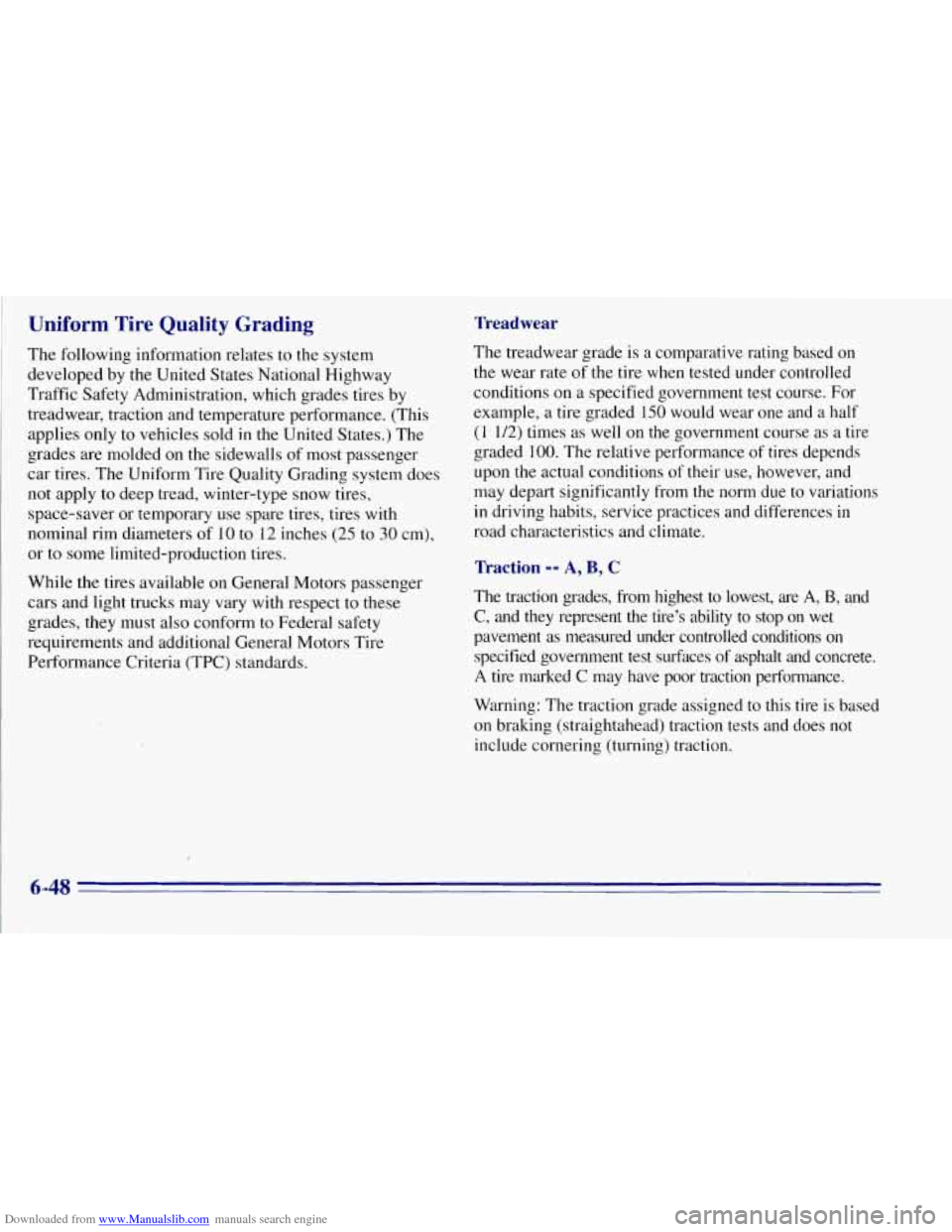
Downloaded from www.Manualslib.com manuals search engine Uniform Tire Quality Grading
The following information relates to the system
developed by
the United States National Highway
Traffic Safety Administration, which grades tires by
treadwear, traction and temperature performance. (This
applies only to vehicles sold
in the United States.) The
grades are molded on the sidewalls
of most passenger
car tires. The Uniform Tire Quality Grading system does
not apply to deep tread, winter-type snow tires,
space-saver or temporary use spare tires, tires with
nominal rim diameters of 10 to 12 inches (25 to
30 cm),
or to some limited-production tires.
While the tires available on General Motors passenger
cars and light trucks may vary with respect to these
grades, they must also conform to Federal safety
requirements and additional General Motors Tire
Performance Criteria (TPC) standards.
Treadwear
The treadwear grade is a comparative rating based on
the wear rate of the tire when tested under controlled
conditions on a specified government test course. For
example, a tire graded 150 would wear one and a half
(1 1/2) times as well on the government course as a tire
graded
100. The relative performance of tires depends
upon the actual conditions
of their use, however, and
may depart significantly from the norm due to variations
in driving habits, service practices and differences in
road characteristics and climate.
Traction -- A, B, C
The traction grades, from highest to lowest, are A, B, and
C, and they represent the tire’s ability to stop on wet
pavement
as measured under controlled conditions on
specified government test surfaces
of asphalt and concrete.
A tire marked C may have poor traction performance.
Warning: The traction grade assigned to this tire is based
on braking (straightahead) traction tests and does not
include cornering (turning) traction.
6-48
Page 302 of 403
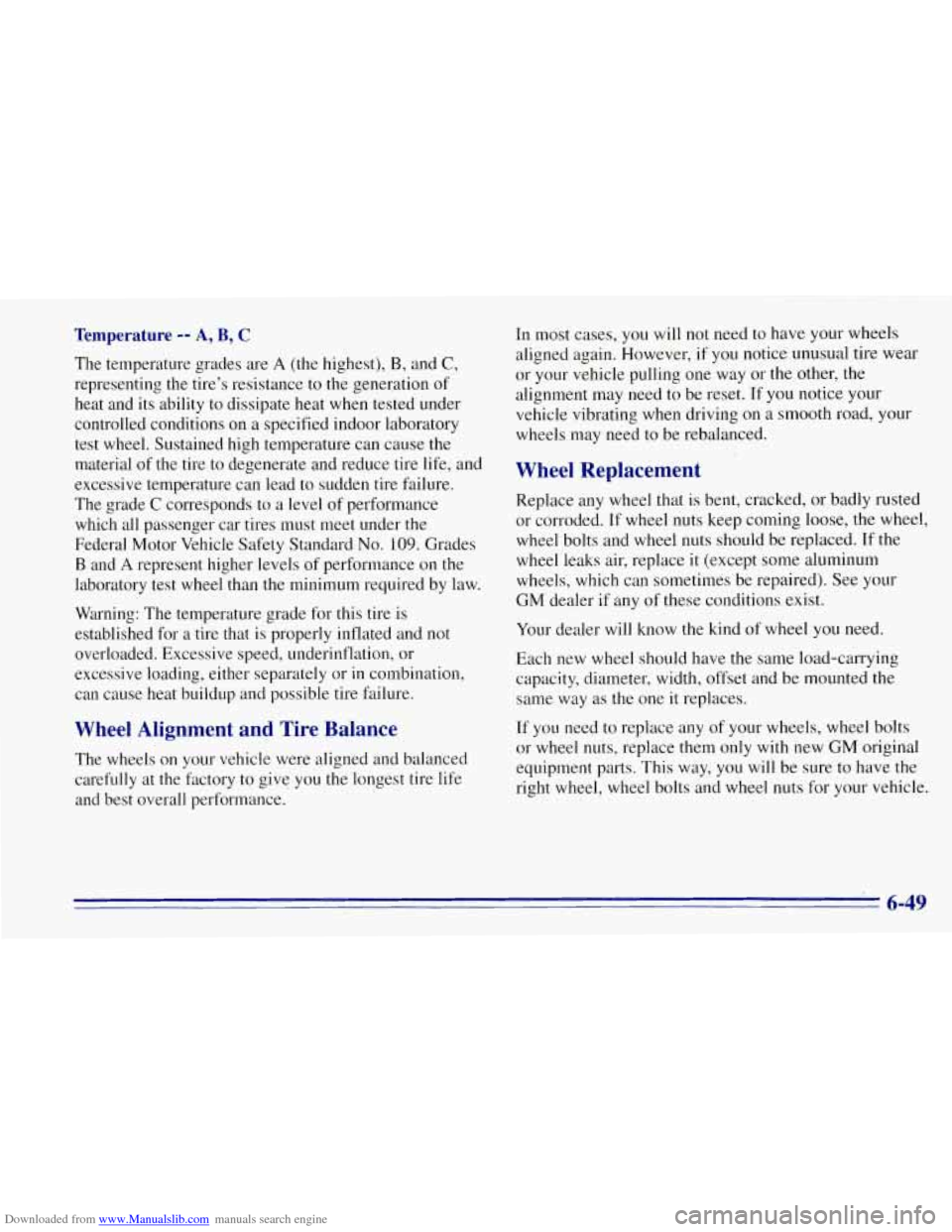
Downloaded from www.Manualslib.com manuals search engine Temperature -- A, B, C
The temperature grades are A (the highest), B, and C,
representing the tire's resistance to the generation of
heat and its ability to dissipate heat when tested under
controlled conditions on a specified indoor laboratory
test wheel. Sustained high temperature can cause the
material
of the tire to degenerate and reduce tire life, and
excessive temperature can lead to sudden tire failure.
The grade
C corresponds to a level of performance
which all passenger car tires must meet under the
Federal Motor Vehicle Safety Standard
No. 109. Grades
B and A represent higher levels of performance on the
laboratory test wheel than the minimum required by law.
Warning: The temperature grade for this tire is
established for a tire that is properly inflated and not
overloaded. Excessive speed, underinflation, or
excessive loading, either separately or
in combination,
can cause heat buildup and possible tire failure.
Wheel' Alignment and Tire Balance
The wheels on your vehicle were aligned and balanced
carefully at the factory
to give you the longest tire life
and best overall performance. In
most cases, you will
not need to have your wheels
aligned again. However,
if you notice unusual tire wear
or your vehicle pulling one way or the other, the
alignment may need to be reset. If
you notice your
vehicle vibrating when driving on a smooth road, your
wheels may need to be rebalanced.
Wheel Replacement
Replace any wheel that is bent, cracked, or badly rusted
or corroded. If wheel nuts keep coming loose, the wheel,
wheel bolts and wheel nuts should be replaced.
If the
wheel leaks air, replace it (except some aluminum
wheels, which can sometimes be repaired). See your
GM dealer if any of these conditions exist.
Your dealer will know the kind of wheel
you need.
Each new wheel should have the same load-carrying
capacity, diameter, width, offset and be mounted the
same way as the one it replaces.
If you need
to replace any of your wheels, wheel bolts
or wheel
nuts, replace them only with new GM original
equipment parts. This way, you will be sure
to have the
right wheel, wheel bolts and wheel nuts for your vehicle.
6-49
Page 304 of 403

Downloaded from www.Manualslib.com manuals search engine Tire Chains
NOTICE:
If your vehicle has P265/75R16 size tires, don’t
use tire chains. They can damage your vehicle. If
you have a tire size other than
P265/75R16, use
tire chains
only where legal and only when you
must. Use chains that are the proper size for your
tires. Install them on the tires of the rear axle.
Don’t use chains
on the tires of the front axle.
Tighten them as tightly as possible with the ends
securely fastened. Drive
slowly and follow the
chain manufacturer’s instructions.
If you can
hear the chains contacting your vehicle, stop
and retighten them. If the contact continues,
slow down until it stops. Driving too fast or
spinning the wheels with chains on will damage
your vehicle.
Appearance Care
Remember, cleaning products can be hazardous. Some
are toxic. Others can burst into flame if you strike
a
match or get them dn a hot part of the vehicle. Some are
dangerous
if you breathe their fumes in a closed space.
When
you use anything from a container to clean your
vehicle, be sure to follow the manufacturer’s warnings
and instructions. And always open your doors or
windows when you’re cleaning the inside.
Never use these to clean your vehicle:
Gasoline
Benzene
Naphtha
Carbon Tetrachloride
Acetone
Paint Thinner
Turpentine
0 Lacquer Thinner
Nail Polish Remover
They can all be hazardous
-- some more than
others
-- and they can all damage your vehicle, too.
6-51
Page 318 of 403
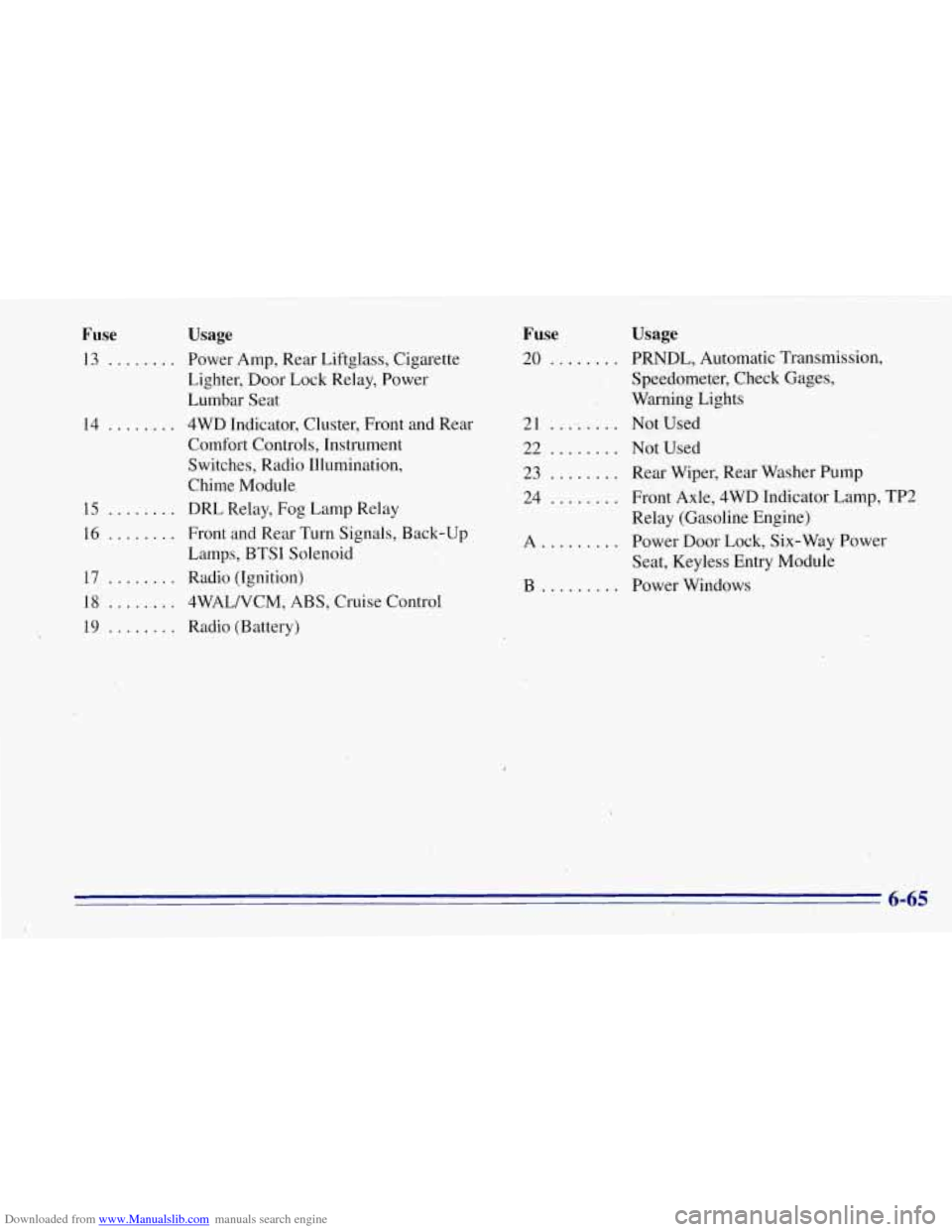
Downloaded from www.Manualslib.com manuals search engine Fuse Usage
13 ........ Power Amp, Rear Liftglass, Cigarette
Lighter, Door Lock Relay, Power
Lumbar Seat
Comfort Controls, instrument
Switches, Radio Illumination,
Chime Module
15
........ DRL Relay, Fog Lamp Relay
16
........ Front and Rear Turn Signals, Back-up
Lamps, BTSI Solenoid
17
........ Radio (Ignition)
18
........ 4WAL/VCM, ABS, Cruise Control
19
........ Radio (Battery)
14
........ 4WD Indicator, Cluster,
Front and Rear
Fuse Usage
20 ........ PRNDL, Automatic Transmission,
4. ,,/ J - ;c- ; Speedometer, Check Gages, .. '.. - *. 1'). 'I :,,:-: . .-.?Warning ,. Lights .- .
21 ........ Not Used
22
........ Not Used
23
........ Rear Wiper, Rear Washer Pump
24
........ Front Axle, 4WD Indicator Lamp, TP2
Relay (Gasoline Engine)
A ......... Power Door Lock, Six-Way Power
Seat, Keyless Entry Module
B ......... Power Windows
6-65
Page 390 of 403

Downloaded from www.Manualslib.com manuals search engine Section 9 Index
Air Bag ...................................... 1-29
Adding Equipment
............................ 1-34
How Does
it Restrain .......................... 1-32
How it Works
................................ 1-3 1
Location .................................... 1-31
Readiness Light
......................... 1.30. 2.59
What Makes it Inflate
.......................... 1-32
What Will
You See After it Inflates ............... 1-33
When Should
it Inflate ......................... 1-32
Aircleaner
.................................... 6-16
Air Cleaner Filter Restriction Indicator Check
........ 7-43
Air Conditioning
................................ 3-6
Air Conditioning Refrigerants
..................... 6-73
Aluminum Wheels. Cleaning
...................... 6-57
Antenna. Fixed
................................. 3-28
Antifreeze
..................................... 6-25
Anti-Lock Brakes
...................................... 4-6
Brake System Warning Light
................ 2.62. 4.6
Anti.Theft. Radio
.............................. 3-24
Appearance Care
............................... 6-5 1
Servicing ................................... 1-34
Alignment and Balance. Tire
...................... 6-49 Appearance Care
Materials
........................ 6-59
Arbitration Program
.............................. 8-7
Ashtrays
...................................... 2-52
Audio Equipment. Adding
........................ 3-26
Audio Systems
.................................. 3-9
Automatic Transmission
Check
...................................... 7-43
Fluid
....................................... 6-18
Operation
................................... 2-14
Overdrive
................................... 2-16
Park Mechanism Check
........................ 7-45
Shifting
..................................... 2-14
Auxiliary Power Outlet
.......................... 2-53
Axle. Front
........................... ......... 6-23
Axle. Locking Rear
............................. 2-17
Axle. Rear
.................................... 6-22
Battery
...................................... 6-35
Jump Starting
................................. 5-2
Replacement. Keyless Entry
..................... 2-5
BBB Auto Line
................................. 8-7
Better Business Bureau Mediation
.. ................ 8-7
Armrest Storage Compartment
.................... 2-47
Warnings
.................................... 5-2
9-1